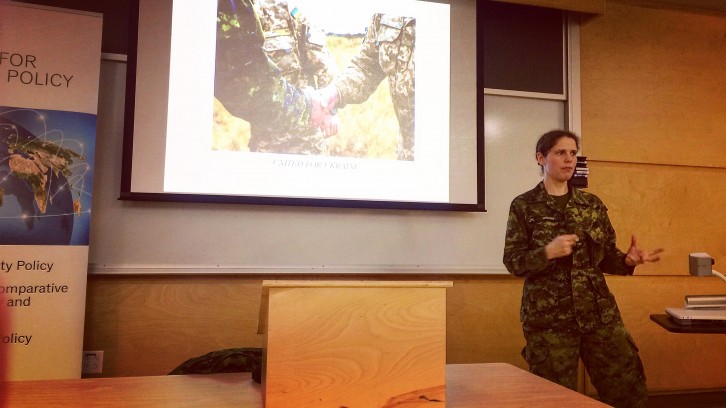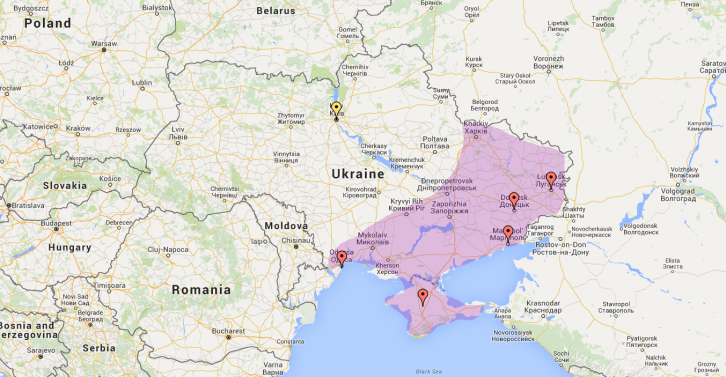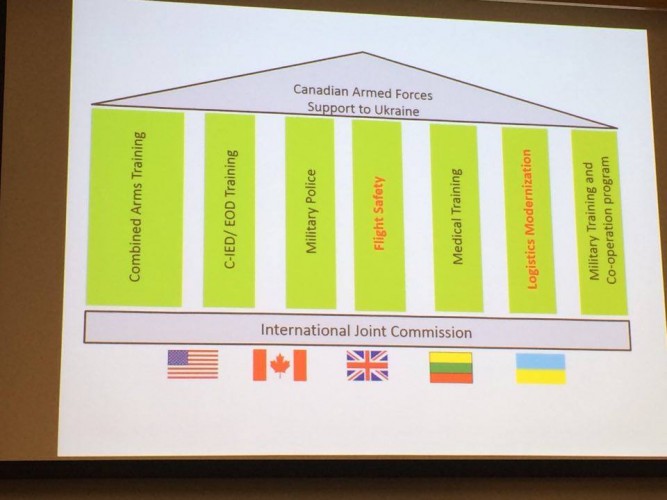Foreign affairs
Operation UNIFIER: Canada has bigger military role in Ukraine
Canada answers Ukraine’s call for help with training and equipment

caption
Major Cindy Legarie talks about Operation UNIFIER
caption
Major Cindy Legarie explains Operation UNIFIERWhile the crisis in Ukraine has seemingly fallen out of the media limelight, the Canadian Armed Forces (CAF) are in the middle of a comprehensive training mission with seven lines of effort (pillars) in Ukraine called Operation UNIFIER.
Hosted by The Centre for Foreign Policy Studies, Maj. Cindy Legarie was at Dalhousie’s law school on Thursday to give a breakdown on what Canada is doing in Ukraine.
She went over how the two countries are working together, and what the future of partnership looks like. The CAF maintain that Operation UNIFIER is a Canadian contribution to Ukraine that is built upon not just military assistance, but development, security, logistics, democracy, and humanitarian aid.
In Ukraine, Legarie is currently Deputy Task Force Commander (DTFC), under Lt.-Col Tim Arsenault, who is serving as commander of Canada’s Joint Task Force Ukraine (JTF-U) having replaced Lt.-Col. Jason Guiney.
On April 14, 2015, the Canadian government announced that it would deploy around 200 CAF personnel to Ukraine until March 31, 2017. The mission is being carried out by six NATO member countries, on behalf of and in co-ordination with Ukraine’s Ministry of Defense, and they have formed an international joint coalition.
This is what the current coalition configuration looks like:
- Canada
- The United States
- The United Kingdom
- Lithuania
- Latvia (expected to join)
- Poland (expected to join)
Legarie said it is important to note that this undertaking is not a combat mission, but a long-term commitment to ensuring Ukraine’s political autonomy and public safety.
“I think it’s important to listen to what Ukraine has to say, to recognize their challenges, and create a mutually beneficial learning environment,” she said.
This operation is a Canadian response to Ukraine’s request for help; the CAF and the Department of Foreign Affairs, Trade, and Development (DFATD) are working together to bolster Ukraine’s forces personnel in order to ensure and enhance the country’s level of sovereignty, security, and stability.
In light of the on-going political and territorial conflicts in Ukraine, which began in November 2013, Canada has taken a strong stance on its unequivocal support for its Eastern European ally.
Ukrainian crisis explained:

caption
HIGHLIGHTED: Donbass region of Ukraine pro-Russian conflict zones. Capital Kyiv in yellow, Donetsk, Luhansk, Mariupol, Odessa, and annexed Crimea in red.In 2013, then-president Viktor Yanukovych halted the groundwork for an association agreement with the European Union (EU) – mass protests ensued.
Backers of this agreement were referred to as the “Euromaidan.” By Feb. 22, 2014, Yanukovych fled the capital city of Kyiv after he was dislodged from power by a parliamentary vote – the former Prime Minister Yulia Tymoshenko was then freed from prison.
When Yanukovych left, there was political upheaval in the eastern and southern portions of Ukraine – where he had drummed up much of the ethnic-Russian support. The Russians then moved into the Ukrainian-held autonomous Republic of Crimea – this landmass was annexed by Russia on March 18, 2014. The inhabitants of Crimea voted for their independence with Russia’s backing.
More unrest occurred in Donetsk and Luhansk – and the War in Donbass between pro-Russian separatists and post-revolutionary Ukrainian government troops continues to this day.
Task Force and Mission Context:

caption
The lines of effort involved in this mission. Those in red have yet to be activated.Along with stiff sanctions placed on Russia, Canada has sent $15 million in non-lethal material and equipment to Ukraine, $220 million in support of the Ukrainian economy, and $3 million to NATO Centres of Excellence (cyber security, energy security, and strategic communications).
The CAF members are in Ukraine on a sustained and periodic basis and are involved in what is called tactical soldier training (training in small teams) to instruct Ukrainian armed forces on individual weapons training, marksmanship, moving as a unit, communication, survival techniques, and ethics.
Other training includes combat first-aid / casualty evacuation, use of force and basic investigative techniques for military police, explosive device disposal (IEDD), and much more.
Perceived challenges:
Oleksandr (Sasha) Kondrashov attended Legarie’s lecture. He is an instructor at Dalhousie’s School of Social Work and specializes in Ukrainian-Canadian heritage, among many other areas.
Kondrashov said Legarie has presented this mission as a means to help the people of Ukraine. He hopes the government of Canada will answer the call and always listen to the Ukrainian perspective. His only worry is that this mission is too short.
“There are lots of challenges with the neighbour country – she did not say in the presentation at all, the word Russia…I found it very precisely interesting,” he said.
Legarie said one of the biggest challenges she foresees is, “balancing national, multinational, and host-nation desires.”

